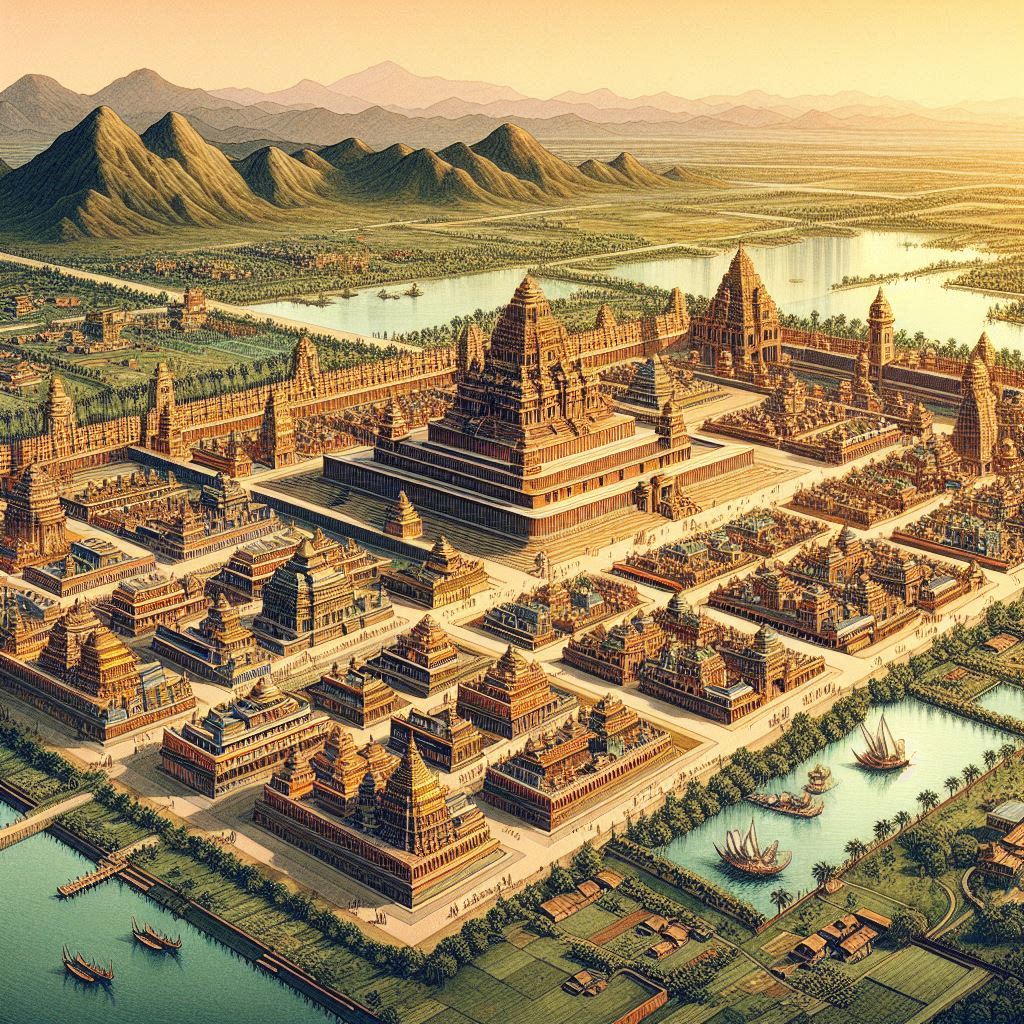The City of Dwarka – Stories from Sabha Parva
Dwarka was the kingdom Krishna built for his people with help from Vishwakarma, the celestial architect. Located to the West of Kuru and near the ocean, it was protected on four sides by high hills.

The kingdom was enclosed within gigantic walls and had gates on four sites. The main entrance was called Vardhamana. Inside the gates, the kingdom was neatly planned to accommodate several thousands of residents, with gardens, parks, etc.
The gardens always flourished with flowering plants and fruit-laden trees and resembled the Nandana in heaven. The royal buildings shone like the sun and moon. The city was surrounded by moats filled with blooming lotus flowers. The Raivataka Hill was on the east on Dwarka, the Latavesta (Rainbow Hill) on the south, Sukaksa Hill on the west, and the Venumanta Hill on the north. Krishna personally planted Vaijayanthi flags on each hill to ensure the safety of Dwarka. The Hamsakuta Hill was also located near Dwarka and was sixty palm trees tall and one yojana in width.
One could see the forests of Panchajanya and Sarvartuka from the Raivataka Hill. This was also the hill where the Yadavas celebrated their yearly festival of worshiping the mountain. The forests of Citrapushpa, Satapatra, Karavira, and Kusumbhi surrounded the Sukaksa Hill, while the Venumanta Hill provided great sights of the Caitraratha, Nandana, Ramana, and Bhavana forests. To the west of Dwarka was a large lake named Pushkarini, which measured a hundred bow lengths. Indradyumna was another big lake in the city and was the favorite spot of the kinnaras.
There were a total of fifty gates to enter Dwarka and each of them was fortified with spear-like and circular devices that prevented enemies from breaching or entering without permission. Outside the city gates, eight thousand chariots sat ready for the warriors to drive.
The central area of the city was approximately eight yojanas wide and twelve yojanas long. The adjoining sections were double this size. It boasted eight major main roads and sixteen crossroads with an intricate network of bylanes. The city was well-connected throughout. There were exclusive herb gardens with all healing herbs from Mount Meru. Krishna brought many plants and trees from Brahma’s world and planted them in Dwarka.
Houses had large windows, flags, and colorful roofs. Music was constantly played in the city and in every house. The upper rooms of the houses displayed bird cages and were studded with gems on the outside. The city glittered like a jewel everywhere. The houses were made of gold, silver, marble, bricks, and other items, depending on the owner’s choice. Every house in Dwarka had bells.
The colors used on the walls and houses were shades of gold, white, cream, etc. This led to a soothing and pleasant feeling.
Krishna’s entire palace was four yojanas square and had countless rooms and mini houses inside. The one where he lived was one yojana square with golden-domed roofs designed to suit Rukmini’s taste. Satyabhama’s palace was white with a gem-studded staircase, a lovely garden, and colorful flags. Jambavati’s palace was between Rukmini’s and Satyabhama’s with a main door glowing like Jambu gold and with the radiance of Mount Kailasa.
Sukesi, Suprabha (palace named Padmakuta), Lakshmana, and Mitravinda also had their own palaces. Mitravinda’s palace was blue-toned and made of lapis lazuli, the same shade as Krishna’s skin. Sudatta’s palace was called Ketuman.
Krishna had his personal resting place or palace called Viraja where he spent some time alone whenever necessary. It was one yojana square and decorated with precious stones, flags, etc.
Numerous birds, animals, cattle, etc., were also found in Dwarka, enjoying the beautiful gardens. Many animals roamed nearby in the surrounding forests. The ocean was to the west side of the kingdom.
